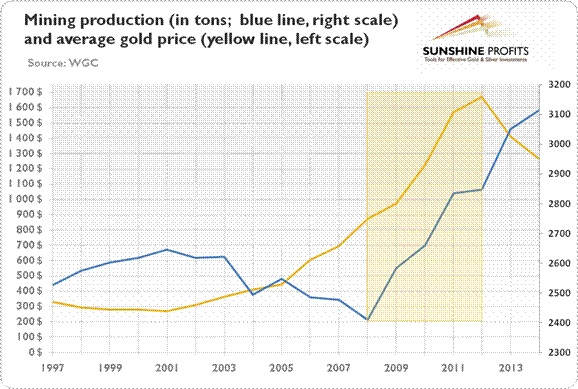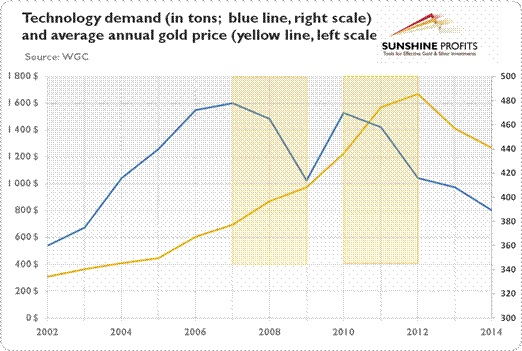Is Production Or Consumption Drivers Of The Gold Price?
There are many opinions about what factors drive the price of gold. Among the candidates you will find: inflation rates, U.S. dollar exchange rate, real interest rate, geopolitics, oil prices, market volatility and crises, mine production, jewelry demand, speculation, technological demand, central banks’ actions, manipulation, and investment demand. We will deal with them in this and the following editions of the gold Market Overview. We will begin by rejecting production and consumption. It does mean that they do not affect the gold price; however we are interested in factors which drive the gold price.
Let’s look at the mine production. Nearly all gold in the world that has ever been produced is still held in some form. This is why mine production is not a key factor driving the gold price. The mining adds only about 1 percent to the total supply each year (and in a rather stable and predictable manner). And an amount equal to the annual mine supply changes hands in less than a week in the London market alone. Therefore the impact of mining production on the gold price is practically negligible.
In other words, gold is hoarded as a monetary asset, and not consumed like other commodities. Because the stock to annual production ratio is around 60, the gold market, unlike other commodity markets, cannot be in a supply deficit, despite the erroneous opinions of many analysts, who treat gold as they do other metals.
They forget that other commodities derive their economic value from being consumed or used as an input in production, whilst people buy gold in order to hold it (even in the case of jewelry, gold is still held and could be melted and come back to the market). Because typical commodities have to be destroyed to use them (coal has to be burned, wheat has to be eaten and so on) or, in case of base metals (like copper used to build pipes), transformed in an irreversible manner, their stockpiles are not large and amount to, in the best case, a few months of production.
Therefore, ignoring inventories, which are not large in the case of typical commodities, supply is mine production and demand means consumption. This is why commodity analysts look at the annual mine supply and industrial off-take. Thus, in the commodity markets the price regulates the flow of production into consumption, or rations the annual production.
However, the gold price rations rather all metal held in the world; therefore in the gold market production does not constrain its price. The gold market is so liquid that even the complete halt of mine production will not affect it significantly (the existing gold owners possess most of gold); hence, mining production does not drive gold prices. All of these analyses on mining industry, peak gold, cash costs, strikes in mines, declining new gold discoveries, an alleged structural deficit and so on are not that important. The gold price significantly influences the gold mining industry, but not the other round way. Look at chart 1. As you can see, mining production has been constantly rising since 2008, but it did not prevent the gold price from rising until 2012.
Chart 3: Mining production (in tons; blue line, right scale) and average annual gold prices (yellow line, left scale) from 1997 to 2014

From the above analysis, it should be clear now that the technology demand is not an important gold price driver either. Unlike other commodities (including even silver), gold is practically consumed not at all. The technology and industrial sectors account for less than 10 percent of the total demand–a lot less than for other commodities. This is precisely one of the reasons why gold was chosen as money.
What is also important is that this category of demand (similarly to mining production) is relatively persistent and steady. The electronic companies contract gold delivery in a stable pattern throughout the year. This predictability ensures that technology demand has little impact on the daily price of gold. Moreover, only a part of gold used by industry is lost and never returned to the market, since more and more gold is being recycled over the long run.
If, as we stated before, technology barely affects the price of gold, it can only support the yellow metal in the long-term (see chart 2, where the industrial demand was falling between 2007 and 2009, and also between 2010 and 2012, during a period when the average annual gold price was rising).
Chart 2: Technology demand (in tons; blue line, right scale) and gold price (yellow line, left scale) from 2002 to 2014

The yellow metal is only a minor input in electronic equipment, and industry firms are not interested in gold speculation and trading since they are price-takers, not price-setters. Again, it is the gold price that affects the technology demand (not immediately, however), not the other round way.
The key take-home message here is that gold cannot be analyzed as a commodity, because it is a monetary asset. The yellow metal has an extremely high stock-to-flows ratio, hence we once again observe that it is practically not consumed, nearly all gold ever mined in history still existing in some form. Therefore, investors should ignore commodity-type approaches when analyzing the gold market since they often lead to the erroneous investment assumptions and conclusions. Specifically, neither mining production nor industrial demand drives the gold prices.
********
Sunshine Profits‘ Gold News Monitor and Market Overview

















